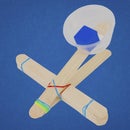Introduction: Electric Fan Car Project for Kids - STEM Classic Made Better
The fan-powered electric car is a classic STEM project for kids because it's easy to create something that moves fast and it's a great way to introduce young engineers to concepts like electricity, inertia, Newton's Laws of Motion, and more.
Most fan car designs feature a fixed propeller and wheels, however the best part about this project is experimenting with your design to discover exciting driving patterns!
To get the most out of this classic project make sure your activity plan includes these 3 things:
- Electronics that are easy for kids to assemble independently.
- Materials that are durable and can be reattached in different configurations.
- Make it easy for kids to test, redesign, and reflect to achieve different driving patterns.
I'll explain why some materials work better than others for this activity, and I'll highlight the best ways the fan car can be modified to change how it drives.
Supplies
- I made some of the electronics and key plastic parts parts available in a kit here on Amazon, or you can source them individually:
- 3V DC electric motor (alternative vendor)- I recommend using motors that have rounded metal housings as these tend to be more powerful. Motors with flat-sided housing are weaker and squat motors like these have low RPM. Flat-sided motors may work for this project but won't produce as much thrust.
- 2 AA battery holder with switch - Two AA batteries are required to power the motor enough to make a fast car. Including the switch simplifies the circuitry for younger kids.
- Plug connectors - Also called bullet connectors, these will make it easy for kids to assemble their circuits and reverse the electrical current. You'll need a crimping tool or a pair of vice grips to use these.
- Motor holder - It's important to securely hold the motor as the plastic propeller is somewhat dangerous. An alternative to this part is to strap the motor to the 1" foam cube using masking tape.
- Small plastic wheels - Lightweight wheels with a small diameter make it easier for the car to overcome inertia and get up to speed quickly. The minimal contact surface with the ground also makes it possible for the cars to drift in circles!
- 1/8" wooden dowel - For connecting the wheels together.
- Sturdy plastic straws - Plastic straws are more resilient than paper ones and they generate less friction from contact with the wooden dowel.
- 12" paint stirrer - For the body of the car. Paint stirrers are lightweight, inexpensive, and provide a large build area. Some hardware stores will give you paint stirrers for free.
- Loom rubber bands - These tiny rubber bands are very durable and make it easy for kids to build with because they require little to no twisting/wrapping to create a secure connection.
- 1" Foam cube - This elevates the motor so the propeller doesn't get close to the ground. Foam cubes are inexpensive, colorful, and lightweight.
- Plastic propeller - Make sure to get a 3 or 4 blade propeller with slender blades and about 3-4" in diameter. Don't use propellers with short bulbous blades, these are designed for aquatic use and won't provide as much air-powered propulsion. If you're concerned about safety you can also experiment with safety propellers although I haven't tested these.
- 1in adhesive squares - These are for attaching the motor. The adhesive is reusable if it's attached to a nonstick surface (and it will be!), which allows kids to easily change the motor position.
- Masking tape (Dispenser) - Easier to work with than duct tape and stronger adhesive than clear tape.
Step 1: Create the Wheels
Fit a wheel onto the end of the dowel. If the fit is loose, wrap a bit of tape or a loom rubber band around the end.
Put a straw onto the dowel, then another wheel on the other end. Repeat to create two sets of wheels.
I don't advise cutting the straw shorter. Wider wheel placement results in a more stable car, and using the whole straw reduces the amount of steps and waste for this project.
Step 2: Attach the Wheels to the Stick
The key to a fast fan-powered car is to make sure it's as lightweight as possible, so this design features only a single paint stirrer as the body of the car.
Use loom rubber bands to attach the wheels to the ends of the paint stirrer. This method is fast and easy, but more importantly it allows the wheels to turn to either side, which changes the direction the car is moving.
Young kids can do this step independently by first putting a rubber band on the paint stirrer, then setting the wheels on top. Pull the rubber bands over the straw and around the end of the paint stirrer again.
Repeat with the second set of wheels, then flip the car over.
Step 3: Apply a Layer of Tape
Add a layer of 1" masking tape on top of the paint stirrer. This makes it possible to reuse the adhesive square without loss of adhesion. Without the tape, the adhesive square will quickly lose its adhesive properties after being reapplied a few times because the paint stirrer's wood fibers will peel off and get stuck to it.
Step 4: Prep and Assemble the Electronics
This step is time-consuming, but think of it this way: You're exchanging your time prepping so kids can have more time to experiment and play with their scribble bot. Additionally the plug connectors make it easy for kids to switch the motor direction, which is another variable that changes the scribble pattern.
Begin prepping by cutting the wire to just ≈3'' (8cm). Short wires are less likely to get tangled in the spinning motor. Strip off 1'' (2.5cm) of insulation. Make sure the wire strands are straight and flat. Insert it into the plug connector, then crimp it tightly. Tug on the connector to make sure it's firmly clamped onto the wire.
From here assembling the circuit is easy, just plug the connectors together! To change the direction the motor spins, switch the wires around.
IMPORTANT: Make sure the hooded socket connectors are used for the battery holder! This prevents the wires from coming into contact with each other and forming a dangerous short circuit.
IMPORTANT: If you opt to not prep the wires with connectors, then be sure to tell your kids how to assemble the circuit so the propeller spins clockwise when facing the motor shaft. It's important that the propeller generates thrust in the direction away from the motor to get the most movement.
Bonus step: Wrap the motor wires in electrical tape. If your motor wires break off easily or you plan on reusing these components with multiple groups of kids I recommend wrapping the wires to the motor with electrical tape. This prevents the wire terminals from bending back and forth and eventually breaking off.
Step 5: Mount the Motor
Fit the motor into the motor mount. If it's loose, wrap some tape around the motor. If it's tight and the holder is bending, use a thicker adhesive pad or use two layers of adhesives.
Apply some foam adhesive pad to the bottom of the mount, then affix it to a 1" foam cube.
Use another adhesive square to attach the cube to the top of the car. Make sure to stick it to the layer of masking tape.
Step 6: Attach the Battery Holder
The battery holder can also be attached with a single loom rubber band using this technique:
- Put a rubber band onto the holder near the switch.
- Place the holder onto the paint stirrer, then pull the rubber band under the paint stirrer.
- Wrap the rubber band around the battery holder again.
Step 7: Experiment!
These cars can take up a lot of space! The best places to test are large indoor areas with no obstructions such as gymnasiums or cafeterias with the seating folded up. Outdoor tennis courts and basketball courts, as well as well-maintained asphalt or concrete that's fairly level will also work. Avoid carpet, cluttered indoor spaces, or bumpy surfaces.
Important: The spinning plastic propeller can cause injury! Make sure to observe your car from a safe distance. Always turn off the car before picking it up. If it crashes and the motor falls off, an adult may need to safely turn off the car. Avoid driving in small enclosed areas. Wear shoes and pants in case the car collides with your ankle.
There are many ways kids can experiment to change the driving pattern:
- Adjust the angle of the wheels by connecting the straw to the paint stirrer with a strip of tape. If the tape gets crumpled or loses its adhesion, just apply a new piece.
- Try a variety wheel angle combinations to achieve different driving patterns, such as wide circles, drifting, straight-and-fast, and more!
- Experiment with the direction the fan is facing. Unstick the foam cube from the tape layer and reattach it somewhere else. Try turning it around the other way, or pointing it off to the side.
- Change where the battery holder is positioned. Since the batteries are so heavy, this affects how much friction is being applied to the front and back wheels, as well as the car's center of mass. Changing the position of the battery holder can alter how much the car spins out or how tightly it can drive in circles.
- Reverse the direction the propeller is spinning by unplugging the wires and switching them around. You might think that this is the same as rotating the motor 180˚, but it's not! Some of the propulsion from the fan can get blocked by the foam cube/motor assembly, so experimenting to find the best force output direction is worthwhile.
Beyond the joy of finding fun driving patterns, this project can be made more challenging by having students keep a small figurine safe even if the car crashes, or challenge them to optimize their design for speed/spinning/etc. Keep finding ways to make the electric fan-powered car more fun and challenging!

Runner Up in the
Make it Move Challenge













